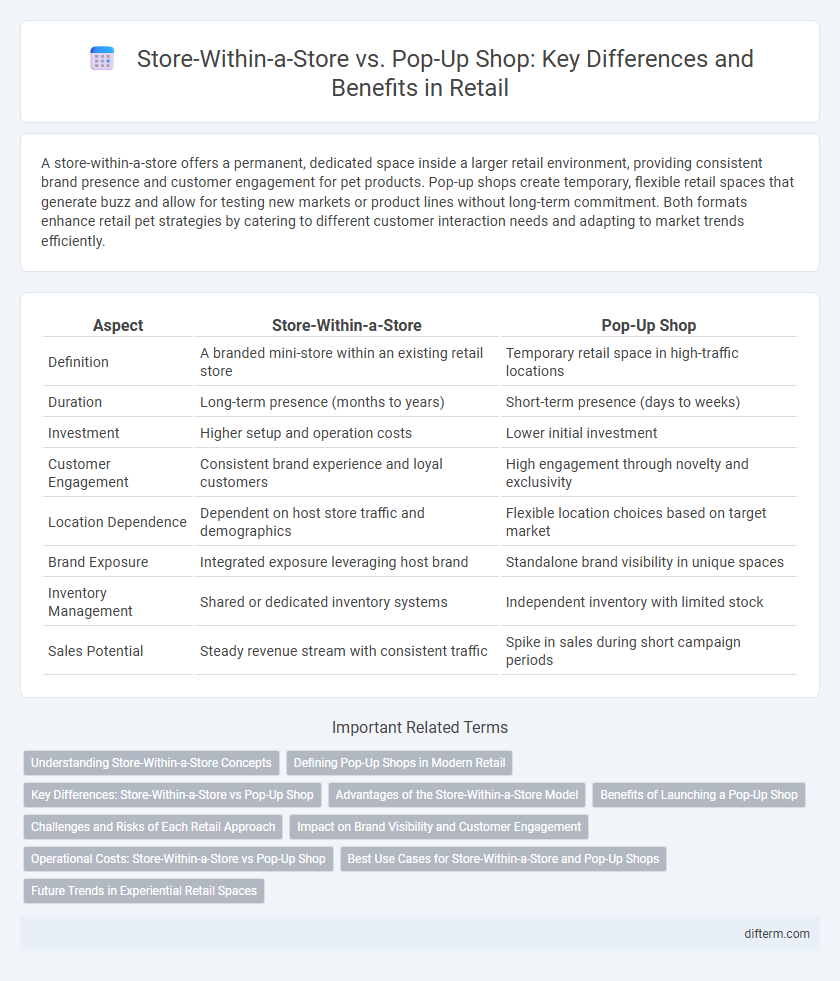A store-within-a-store offers a permanent, dedicated space inside a larger retail environment, providing consistent brand presence and customer engagement for pet products. Pop-up shops create temporary, flexible retail spaces that generate buzz and allow for testing new markets or product lines without long-term commitment. Both formats enhance retail pet strategies by catering to different customer interaction needs and adapting to market trends efficiently.
Table of Comparison
| Aspect | Store-Within-a-Store | Pop-Up Shop |
|---|---|---|
| Definition | A branded mini-store within an existing retail store | Temporary retail space in high-traffic locations |
| Duration | Long-term presence (months to years) | Short-term presence (days to weeks) |
| Investment | Higher setup and operation costs | Lower initial investment |
| Customer Engagement | Consistent brand experience and loyal customers | High engagement through novelty and exclusivity |
| Location Dependence | Dependent on host store traffic and demographics | Flexible location choices based on target market |
| Brand Exposure | Integrated exposure leveraging host brand | Standalone brand visibility in unique spaces |
| Inventory Management | Shared or dedicated inventory systems | Independent inventory with limited stock |
| Sales Potential | Steady revenue stream with consistent traffic | Spike in sales during short campaign periods |
Understanding Store-Within-a-Store Concepts
Store-within-a-store concepts embed one brand's retail space inside another's, enabling shared foot traffic and enhanced customer experiences through curated product selections. This model benefits from long-term partnerships and integrated operations, often resulting in higher brand visibility and sustained sales growth compared to transient retail formats. Retailers leverage store-within-a-store strategies to optimize space utilization, foster brand collaboration, and create seamless shopping journeys that drive customer loyalty.
Defining Pop-Up Shops in Modern Retail
Pop-up shops are temporary retail spaces that enable brands to create immersive, time-limited shopping experiences, often located within existing stores or high-traffic areas. These agile retail formats allow businesses to test new markets, launch products, and engage customers with minimal long-term commitment and reduced overhead costs compared to traditional stores. Pop-up shops leverage innovation and exclusivity to boost brand awareness and drive immediate sales within the competitive retail landscape.
Key Differences: Store-Within-a-Store vs Pop-Up Shop
Store-within-a-store concepts involve a permanent retail space housed within a larger store, leveraging established foot traffic and brand association, while pop-up shops are temporary retail spaces designed for short-term engagement and rapid market testing. Store-within-a-store models benefit from long-term partnerships and consistent customer access, contrasting with pop-up shops' flexibility and limited-time exclusivity. The key differences lie in duration, scale, and strategic objectives, where store-within-a-store emphasizes ongoing retail integration and pop-up shops focus on creating urgency and unique experiences.
Advantages of the Store-Within-a-Store Model
The store-within-a-store model offers established brands a permanent retail space inside a larger store, increasing customer trust and brand visibility through consistent presence. This model benefits from lower startup costs and shared operational resources compared to standalone stores, enhancing profitability. Enhanced customer convenience and integrated shopping experiences drive higher foot traffic and sales conversion rates within the host retailer.
Benefits of Launching a Pop-Up Shop
Launching a pop-up shop offers retailers a flexible, low-investment way to test new markets and engage customers with unique, time-limited experiences that drive urgency and excitement. Pop-up shops enhance brand visibility and allow direct interaction with consumers, fostering immediate feedback and increasing customer loyalty. By leveraging high foot traffic locations temporarily, retailers can boost sales and create buzz without the long-term commitment of a store-within-a-store setup.
Challenges and Risks of Each Retail Approach
Store-within-a-store models face challenges such as brand dilution, complex revenue sharing agreements, and operational integration issues between the host retailer and the embedded brand. Pop-up shops carry risks including unpredictable foot traffic, short-term lease costs, inventory management difficulties, and limited time for brand recognition. Both approaches require careful strategic planning to mitigate financial exposure and maintain customer experience consistency.
Impact on Brand Visibility and Customer Engagement
Store-within-a-store formats significantly enhance brand visibility by creating permanent, branded environments within established retailers, fostering deeper customer engagement through immersive shopping experiences. Pop-up shops generate buzz and attract high foot traffic temporarily, boosting short-term brand awareness and encouraging immediate customer interaction with exclusive offers. Both models effectively increase customer touchpoints, but store-within-a-store strategies build sustained brand loyalty, while pop-ups excel at sparking viral interest and trial purchases.
Operational Costs: Store-Within-a-Store vs Pop-Up Shop
Operational costs for a store-within-a-store often include shared expenses such as rent, utilities, and staffing with the host store, resulting in lower overhead compared to standalone setups. Pop-up shops typically incur higher short-term costs for setup, marketing, and temporary staffing but benefit from flexible lease terms and minimal long-term commitments. Retailers must evaluate these cost structures based on their budget constraints and strategic goals for seasonal or experimental product launches.
Best Use Cases for Store-Within-a-Store and Pop-Up Shops
Store-within-a-store models excel in maximizing brand visibility and driving sales by integrating established brands within high-traffic retail environments, ideal for long-term partnerships and enhancing customer loyalty through immersive experiences. Pop-up shops are best suited for testing new markets, launching limited-edition products, and creating buzz with time-sensitive promotions that capitalize on scarcity and exclusivity. Both formats optimize retail strategies by leveraging location-specific consumer behavior, but pop-ups offer agility while store-within-a-store provides sustained brand presence.
Future Trends in Experiential Retail Spaces
Store-within-a-store concepts leverage established brand presence to create immersive shopping experiences that drive customer loyalty and increase average transaction value. Pop-up shops offer flexibility and innovation, enabling retailers to test new markets, products, and consumer interactions with lower investment and risk. Emerging technologies like augmented reality and data analytics are enhancing both formats, shaping the future of experiential retail by personalizing engagement and optimizing spatial design.
store-within-a-store vs pop-up shop Infographic

 difterm.com
difterm.com